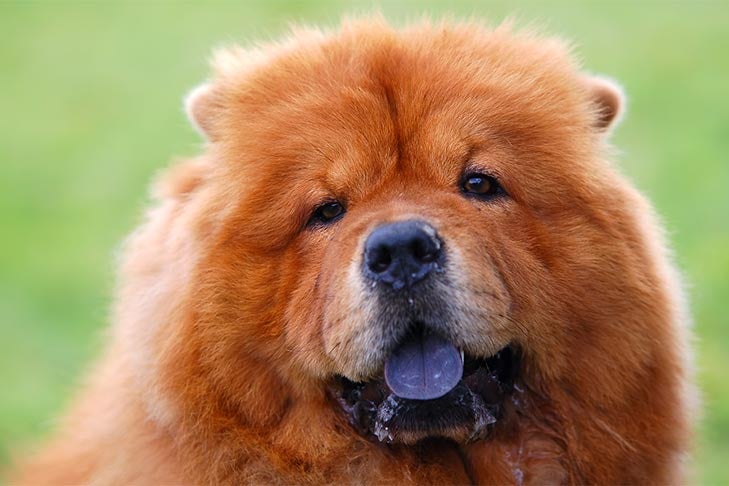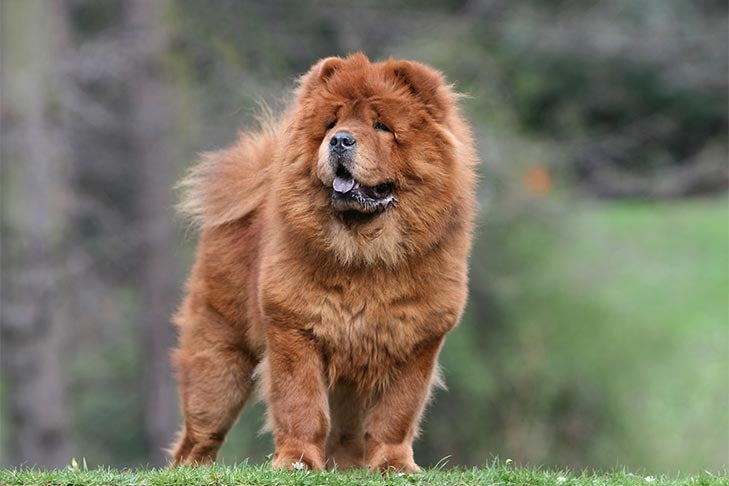
Everything about the Chow Chow captures the imagination, from its magnificent, lion-like appearance to its long and storied history, but nothing catches the eye quite like his tongue. The Chow Chow’s blue-black tongue sets it apart from almost every other dog breed. But why do Chows have blue tongues? We reached out to Linda Love Banghart, an officer in the Chow Chow Club, Inc., to find out why Chow Chows have blue tongues, as well as a little more information about this unique dog breed.
How Did Chows Get Blue Tongues?
Chow Chows, also known as Chows, are one of the world’s oldest dog breeds. They appear in Chinese artifacts from as far back as 206 B.C., and other evidence suggests this breed goes back much further. According to Banghart, there is “no documentation of why Chow Chows have a blue-black tongue” despite this lengthy history, but fictional explanations do exist. Some of these tales include the belief that when the world was created, Chow Chows were allowed to lick up all the little pieces of blue sky that fell on the earth when the stars were set in their places, or they inherited their tongues from a bear. While the Chow Chow’s appearance is certainly bearish, the real reason for the distinctive tongue remains unknown.
What we do know is that Chows had their blue tongues in the 1820s when they were exhibited at the London Zoo as “the wild dogs of China.” Caretakers noticed the blue-black coloring of their mouths and tongue, and “as managed breeding began,” Banghart says, “this unique characteristic was used as a requirement for identifying purebred offspring.”
This requirement continues today. The breed standard states:
Mouth and Tongue – Edges of the lips black, tissues of the mouth mostly black, gums preferably black. A solid black mouth is ideal. The top surface and edges of the tongue a solid blue-black, the darker the better. Disqualifying Fault – The top surface or edges of the tongue red or pink or with one or more spots of red or pink.

Do Blue Spots On a Dog’s Tongue Mean the Dog Is Part Chow?
You may have heard someone point to a blue spot on a dog’s tongue and tell you, “That means the dog is part Chow.”
It isn’t that simple. While a blue-black tongue could mean that a dog has Chow Chow in his bloodlines, these spots are also found periodically in many pure breeds, including Newfoundlands and Labrador Retrievers. The difference between these spots and the Chow Chow’s tongue is that these spots are not considered hereditary and may be simply random pigmented skin cells, whereas the Chow Chow’s blue tongue is one of its identifying characteristics.
Can Chow Chow Tongues Be Other Colors?
Chow Chows are not born with blue tongues. In fact, Chow Chow puppies have pink tongues, just like other breeds. The blue-black color develops as their eyes open. “Sometimes the pigment change is slower, but the tongue pigment must always be complete by the time the puppy is about six months old,” says Banghart. “A Chow Chow with incomplete pigment won’t be eligible to compete in conformation dog shows and is disqualified from the breed standard.”
What Other Breeds Have Blue Tongues?
The Chow’s blue tongue makes it unique in the dog world, with one exception: the Chinese Shar-Pei. Like the Chow Chow, the Shar-Pei’s breed standard requires bluish-black pigmentation in the mouth and tongue, with exceptions made for dilute colors, which may have lavender pigmentation. (According to the Chinese Shar-Pei coat color DNA study, “dilute” refers to the nose pigmentation primarily, not the coat color. Any nose other than black is considered dilute.)
Chow Chows and Chinese Shar-Pei probably share distant ancestors, which explains the similarity between the two. They also share their blue-black tongues with polar bears, giraffes, and several breeds of cattle.
Think the Chow Chow is the breed for you? You can find Chow Chow puppies from reputable breeders on the AKC Marketplace.

